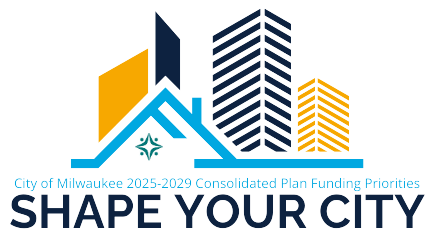PROJECT
City of Milwaukee Consolidated Plan

Partners Involved
Community Development Grants Administration (CDGA) contracts with UEDA to assist with putting together the Consolidated Plan.
Project Team
Kristi Luzar, UEDA
Tim Syth, Contexture
Andrea Rodriguez, Thrive MKE
Evan Sandherr, Collective Audacity
Una Van Duvall
NSP Organizational Partners
Riverwest Development Corporation
Safe & Sound, Inc.
Havenwoods Economic Development Corp.
Sherman Park Community Association
WestCare Wisconsin, Inc.
Dominican Center for Women, Inc.
Running Rebels
Rooted & Rising – Washington Park
Midtown Neighborhood Alliance
Boys and Girls Club of Greater Milwaukee
Near West Side Partners
VIA CDC
South Side Organizing Center (SOC)
Learn More
How Do I Help?
- Share the Community Survey (available in English, Spanish & other languages)
- Use #conplanmke in any social media posts. This helps get it to a wider audience!
- Be sure to add the link (https://conplanmke.org/) in addition to the QR code when possible
- An image helps grab more attention than text alone
- Host a meeting, help get the word out! Offer incentives if possible.
- Visit www.conplanmke.org for survey links
The ConPlan, or Consolidated Plan, is a five year plan that is submitted to the U.S. Department of Housing and Urban Development (HUD). The HUD website states the following:
“The Consolidated Plan is designed to help states and local jurisdictions to assess their affordable housing and community development needs and market conditions, and to make data-driven, place-based investment decisions. The consolidated planning process serves as the framework for a community-wide dialogue to identify housing and community development priorities that align and focus funding from the CPD formula block grant programs.”
Access the ConPlan Overview Presentation for more information.
View the 2020-2024 City of Milwaukee ConPlan, including 10 “Navigator” tools that focus on one issue in the plan, highlighting goals, assets and opportunities, strategies, and community feedback.
Goals & Challenges:
The Consolidated Planning process is an opportunity to listen to a diverse set of voices which will inform civic leaders and shape community-focused programs over the next five years. Throughout the community engagement process, we hope to:
Identify Existing Assets
- Incorporate work that has already been done by other groups (e.g. area or neighborhood plans, community planning efforts, other City initiatives in housing and economic development).
- Align and connect with other community engagement efforts (e.g. Growing MKE, community health needs assessment).
Provide Context
- Plan to educate.
- Use experts and data to define the scope of data collected.
- Work in collaboration to positively facilitate complaints and manage expectations.
Attend Community Gatherings
- Make use of pre-existing convenings.
- Prepare for multiple formats and durations.
- Include the “fun factor” (interactive discussion, games/activities, incentives) – we really want to know what people think!
Survey & Interview
- Disseminate community survey tool in digital and paper format. Boost participation using social media and other networks.
- Offer and facilitate focused small-group discussions with affinity groups to leverage expertise of people active in housing and economic development.
- Seek out residents and community leaders for their direct input and feedback. Be present at neighborhood and community events when possible.
Approach:
- Public input and community engagement (June-November 2024)
- Community survey, focus groups, public meetings with neighborhood organizations, outreach events, interviews with key stakeholders
- Quantitative data collection, review & analysis (September-December 2024)
-
- Housing and economic data provided by HUD, City of Milwaukee department plans, Data You Can Use Neighborhood Indicators, research / white papers
- Drafting and editing of the plan, public comment (January-March 2025)
- Submit plan to HUD (Spring 2025)
- Share plan with the Community
Impact:
This is our chance to:
- Shape and participate in Milwaukee’s future.
- Establish priorities and identify barriers for housing.
- Establish priorities and goals for economic and business development.
- Celebrate opportunities and identify assets in our neighborhoods.
- Clearly define our critical community needs.
Why is this important?
This document can become an opportunity to inform funding, activities, community programs, available resources, and development outcomes. This plan also helps align local and regional leadership.
For example, past City of Milwaukee HUD Consolidated Plans included data and activities related to:
- Accessing FEMA funding to address flooding
- Crime and safety initiatives
- Clean-up of contaminated sites
- Lead-based paint abatement
- Housing development and repair
- Acquisition of properties for rehabilitation
- Homeownership counseling & assistance
- Fair housing activity and referrals
- Neighborhood cleanups
- Workforce and youth services

